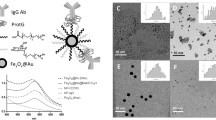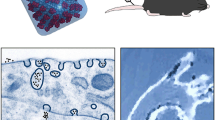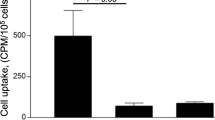Abstract
Purpose
The cell surface adhesion molecule CD44 plays important roles in the initiation and development of atherosclerotic plaques. We aim to develop nanoparticles that can selectively target CD44 for the non-invasive detection of atherosclerotic plaques by magnetic resonance imaging.
Methods
Magnetic glyconanoparticles with hyaluronan immobilized on the surface have been prepared. The binding of these nanoparticles with CD44 was evaluated in vitro by enzyme linked immunosorbent assay, flow cytometry and confocal microscopy. In vivo magnetic resonance imaging of plaques was performed on an atherosclerotic rabbit model.
Results
The magnetic glyconanoparticles can selectively bind CD44. In T2* weighted magnetic resonance images acquired in vivo, significant contrast changes in aorta walls were observed with a very low dose of the magnetic nanoparticles, allowing the detection of atherosclerotic plaques. Furthermore, imaging could be performed without significant delay after probe administration. The selectivity of hyaluronan nanoparticles in plaque imaging was established by several control experiments.
Conclusions
Magnetic nanoparticles bearing surface hyaluronan enabled the imaging of atherosclerotic plaques in vivo by magnetic resonance imaging. The low dose of nanoparticles required, the possibility to image without much delay and the high biocompatibility are the advantages of these nanoparticles as contrast agents for plaque imaging.







Similar content being viewed by others
Abbreviations
- DLS:
-
Dynamic light scattering
- ELISA:
-
Enzyme linked immunosorbent assay
- FITC:
-
Fluorescein isothiocyanate
- FSPGR:
-
Fast spoiled gradient recalled
- HA:
-
Hyaluronan
- IL:
-
Interleukin
- LDL:
-
Low density lipoprotein
- mAb:
-
Monoclonal antibody
- MRI:
-
Magnetic resonance imaging
- NPs:
-
Nanoparticles
- ROI:
-
Region of interest
- siRNA:
-
Small interfering RNA
- SPION:
-
Superparamagnetic iron oxide nanoparticle
- TEM:
-
Transmission electron microscopy
- TNF-α:
-
Tumor necrosis factor-α
References
Libby P. Inflammation in atherosclerosis. Nature. 2002;420:868–74.
Sanz J, Fayad ZA. Imaging of atherosclerotic cardiovascular disease. Nature. 2008;451:953–7.
Canet-Soulas E, Letourneur D. Biomarkers of atherosclerosis and the potential of MRI for the diagnosis of vulnerable plaque. Magn Reson Mater Phy. 2007;20:129–42.
Briley-Saebo KC, Mulder WJM, Venkatesh Mani V, Hyafil F, Amirbekian V, Aguinaldo JGS, et al. Magnetic resonance imaging of vulnerable atherosclerotic plaques: current imaging strategies and molecular imaging probes. J Mag Res Imag. 2007;26:460–79.
Jaffer FA, Libby P, Weissleder R. Molecular and cellular imaging of atherosclerosis. Emerging applications. J Am Coll Cardiol. 2006;47:1328–38.
Amirbekian V, Lipinski MJ, Briley-Saebo KC, Amirbekian S, Aguinaldo JGS, Weinreb DB, et al. Detecting and assessing macrophages in vivo to evaluate atherosclerosis noninvasively using molecular MRI. Proc Nat Acad Sci U S A. 2007;104:961–6.
Nair SA, Kolodziej AF, Bhole G, Greenfield MT, McMurry TJ, Caravan P. Monovalent and bivalent fibrin-specific MRI contrast agents for detection of thrombus. Angew Chem Int Ed. 2008;47:4918–21.
Winter PM, Caruthers SD, Zhang H, Williams TA, Wickline SA, Lanza GM. Antiangiogenic synergism of integrin-targeted Fumagillin nanoparticles and atorvastatin in atherosclerosis. JACC: Cardiovasc Imaging. 2008;1:624–34.
Winter PM, Neubauer AM, Caruthers SD, Harris TD, Robertson JD, Williams TA, et al. Endothelial avb3 integrin-targeted Fumagillin nanoparticles inhibit angiogenesis in atherosclerosis. Arterioscler Thromb Vasc Biol. 2006;26:2103–9.
Bhave G, Lewis JB, Chang SS. Association of gadolinium based magnetic resonance imaging contrast agents and nephrogenic systemic fibrosis. J Urol. 2008;180:830–5.
Thorek DLJ, Chen AK, Czupryna J, Tsourkas A. Superparamagnetic iron oxide nanoparticle probes for molecular imaging. Ann Biomed Eng. 2006;34:23–38.
Sigovan M, Boussel L, Sulaiman A, Sappey-Marinier D, Alsaid H, Desbleds-Mansard C, et al. Rapid-clearance iron nanoparticles for inflammation imaging of atherosclerotic plaque: initial experience in animal model. Radiology. 2009;252:401–9.
Morris JB, Olzinski AR, Bernard RE, Aravindhan K, Mirabile RC, Boyce R, et al. p38 MAPK inhibition reduces aortic ultrasmall superparamagnetic iron oxide uptake in a mouse model of atherosclerosis. MRI assessment. Arterioscler Thromb Vasc Biol. 2008;28:265–71.
Durand E, Raynaud JS, Bruneval P, Brigger I, Al Haj Zen A, Mandet C, et al. Magnetic resonance imaging of ruptured plaques in the rabbit with ultrasmall superparamagnetic particles of iron oxide. J Vasc Res. 2007;44:119–28.
Ruehm SG, Corot C, Vogt P, Kolb S, Debatin JF. Magnetic resonance imaging of atherosclerotic plaque with ultrasmall superparamagnetic particles of iron oxide in hyperlipidemic rabbits. Circulation. 2001;103:415–22.
Hyafil F, Laissy J-P, Mazighi M, Tchétché D, Louedec L, Adle-Biassette H, et al. Ferumoxtran-10–Enhanced MRI of the hypercholesterolemic rabbit aorta relationship between signal loss and macrophage infiltration. Arterioscler Thromb Vasc Biol. 2006;26:176–81.
Weissleder R, Stark DD, Engelstad BL, Bacon BR, Compton CC, White DL, et al. Superparamagnetic iron oxide: pharmacokinetics and toxicity. Am J Roentgenol. 1989;152:167–73.
Singh N, Kenkins GJS, Asadi R, Doak SH. Potential toxicity of Superparamagnetic Iron Oxide Nanoparticles (SPION). Nano Rev. 2010;1:5358.
McAteer MA, Schneider JE, Ali ZA, Warrick N, Bursill CA, Von zur Muhlen C, et al. Magnetic resonance imaging of endothelial adhesion molecules in mouse atherosclerosis using dual-targeted microparticles of iron oxide. Arterioscler Thromb Vasc Biol. 2008;28:77–83.
Nahrendorf M, Jaffer FA, Kelly KA, Sosnovik DE, Aikawa E, Libby P, et al. Noninvasive vascular cell adhesion Molecule-1 imaging identifies inflammatory activation of cells in atherosclerosis. Circulation. 2006;114:1504–11.
Kelly KA, Allport JR, Tsourkas A, Shinde-Patil VR, Josephson L, Weissleder R. Detection of vascular adhesion molecule-1 expression using a novel multimodal nanoparticle. Circ Res. 2005;96:327–36.
Smith BR, Heverhagen J, Knopp M, Schmalbrock P, Shapiro J, Shiomi M, et al. Localization to atherosclerotic plaque and biodistribution of biochemically derivatized Superparamagnetic Iron Oxide Nanoparticles (SPIONs) contrast particles for Magnetic Resonance Imaging (MRI). Biomed Microdevices. 2007;9:719–27.
Sosnovik DE, Schellenberger EA, Nahrendorf M, Novikov MS, Matsui T, Dai G, et al. Magnetic resonance imaging of cardiomyocyte apoptosis with a novel magneto-optical nanoparticle. Magn Reson Med. 2005;54:718–24.
Tu C, Ng TSC, Sohi HK, Palko HA, House A, Jacobs RE, et al. Receptor-targeted iron oxide nanoparticles for molecular MR imaging of inflamed atherosclerotic plaques. Biomaterials. 2011;32:7209–16.
Radermacher KA, Beghein N, Boutry S, Laurent S, Elst LV, Muller RN, et al. In vivo detection of inflammation using pegylated iron oxide particles targeted at E-selectin a multimodal approach using MR Imaging and EPR Spectroscopy. Invest Radiol. 2009;44:398–404.
Kang HW, Josephson L, Petrovsky A, Weissleder R, Bogdanov A. Magnetic resonance imaging of inducible E-selectin expression in human endothelial cell culture. Bioconjugate Chem. 2002;13:122–7.
Crowther MA. Pathogenesis of Atherosclerosis. Hematol. 2005:436–41.
Zhao L, Lee E, Zukas AM, Middleton MK, Kinder M, Acharya PS, et al. CD44 expressed on both bone marrow–derived and non–bone marrow–derived cells promotes atherogenesis in ApoE-deficient mice. Arterioscler Thromb Vasc Biol. 2008;28:1283–9.
Zhao L, Hall JA, Levenkova N, Lee E, Middleton MK, Zukas AM, et al. CD44 regulates vascular gene expression in a proatherogenic environment. Arterioscler Thromb Vasc Biol. 2007;27:886–92.
Cuff CA, Kothapalli D, Azonobi I, Chun S, Zhang Y, Belkin R, et al. The adhesion receptor CD44 promotes atherosclerosis by mediating inflammatory cell recruitment and vascular cell activation. J Clin Invest. 2001;108:1031–40.
Hägg D, Sjöberg S, Hultén LM, Fagerberg B, Wiklund O, Rosengren A, et al. Augmented levels of CD44 in macrophages from atherosclerotic subjects: a possible IL-6–CD44 feedback loop? Atherosclerosis. 2007;190:291–7.
McKee CM, Penno MB, Cowman M, Burdick MD, Strieter RM, Bao C, et al. Hyaluronan (HA) fragments induce chemokine gene expression in alveolar macrophages: the role of HA size and CD44. J Clin Invest. 1996;98:2403–13.
Jain M, He Q, Lee W-S, Kashiki S, Foster LC, Tsai J-C, et al. Role of CD44 in the reaction of vascular smooth muscles cells to arterial wall injury. J Clin Invest. 1996;97:596–603.
Puré E, Cuff CA. A crucial role for CD44 in inflammation. Trends Mol Med. 2001;7:213–21.
Krettek A, Sukhova GK, Schönbeck U, Libby P. Enhanced expression of CD44 variants in human atheroma and abdominal aortic aneurysm. Possible role for a feedback loop in endothelial cells. Am J Pathol. 2004;165:1571–81.
Kolodgie FD, Burke AP, Farb A, Weber DK, Kutys R, Wight TN, et al. Differential accumulation of proteoglycans and hyaluronan in culprit lesions. Insights into plaque erosion. Arterioscler Thromb Vasc Biol. 2002;22:1642–8.
Kinscherf R, Wagner M, Kamencic H, Bonaterra GA, Hou D, Schiele RA, et al. Characterization of apoptotic macrophages in atheromatous tissue of humans and heritable hyperlipidemic rabbits. Atherosclerosis. 1999;144:33–9.
Ponta H, Sherman L, Herrlich PA. CD44: from adhesion molecules to signalling regulators. Nature Rev Mol Cell Biol. 2003;4:33–45.
Lapcik Jr L, Lapcik L, De Smedt S, Demeester J, Chabrecek P. Hyaluronan: preparation, structure, properties, and applications. Chem Rev. 1998;98:2663–84.
Nandi A, Estess P, Siegelman MH. Hyaluronan anchoring and regulation on the surface of vascular endothelial cells is mediated through the functionally active form of CD44. J Biol Chem. 2000;275:14939–48.
Levesque MC, Haynes BF. In vitro culture of human peripheral blood monocytes induces hyaluronan binding and up-regulates monocyte variant CD44 lsoform expression. J Immunol. 1996;156:1557–65.
Brown KL, Maiti A, Johnson P. Role of sulfation in CD44-mediated hyaluronan binding induced by inflammatory mediators in human CD14 peripheral blood monocytes. J Immunol. 2001;167:5367–74.
Maiti A, Maki G, Johnson P. TNF-alpha induction of CD44-mediated leukocyte adhesion by sulfation. Science. 1998;282:941–3.
DeGrendele HC, Estess P, Siegelman MH. Requirement for CD44 in activated T cell extravasation into an inflammatory site. Science. 1997;278:672–5.
DeGrendele HC, Estess P, Picker LJ, Siegelman MH. CD44 and its ligand hyaluronate mediate rolling under physiologic flow: a novel lymphocyte-endothelial cell primary adhesion pathway. J Exp Med. 1996;183:1119–30.
El-boubbou K, Huang X. Glyco-nanomaterials: translating insights from the “Sugar-Code” to biomedical applications. Curr Med Chem. 2011;18:2060–78.
Palmacci S, Josephson L, Groman EV. Synthesis of Polysaccharide Covered Superparamagnetic Oxide Colloids. US Patent WO/1995/005669. 1995.
Kamat M, El-boubbou K, Zhu D, Lansdell T, Lu X, Li W, et al. Hyaluronic acid immobilized magnetic nanoparticles for active targeting and imaging of macrophages. Bioconjugate Chem. 2010;21:2128–35.
El-Dakdouki MH, El-boubbou K, Zhu DC, Huang X. A simple method for the synthesis of hyaluronic acid coated magnetic nanoparticles for highly efficient cell labelling and in vivo imaging. RSC Adv. 2011;1:1449–52.
El-Dakdouki MH, Zhu DC, El-boubbou K, Kamat M, Chen J, Li W, et al. Development of multifunctional hyaluronan-coated nanoparticles for imaging and drug delivery to cancer cells. Biomacromolecules. 2012;13:1144–51.
Alexis F, Pridgen E, Molnar LK, Farokhzad OC. Factors affecting the clearance and biodistribution of polymeric nanoparticles. Mol Pharmaceutics. 2008;5:505–15.
Davignon J, Ganz P. Role of endothelial dysfunction in atherosclerosis. Circulation. 2004;109:III27–32.
Bouïs D, Hospers GAP, Meijer C, Molema G, Mulder NH. Endothelium in vitro: a review of human vascular endothelial cell lines for blood vessel-related research. Angiogenesis. 2001;4:91–102.
Hurt EM, Kawasaki BT, Klarmann GJ, Thomas SB, Farrar WL. CD44+CD24- prostate cells are early cancer progenitor/stem cells that provide a model for patients with poor prognosis. Br J Cancer. 2008;98:756–65.
Dhir R, Gau JT, Krill D, Bastacky S, Bahnson RR, Cooper DL, et al. CD44 expression in benign and neoplastic human prostates. Mol Diagn. 1997;2:197–204.
Yanni AE. The laboratory rabbit: an animal model of atherosclerosis research. Lab Animals. 2004;38:246–56.
Cichy J, Puré E. The liberation of CD44. J Cell Biol. 2003;161:839–43.
El-Dakdouki MH, Huang X. Biological applications of hyaluronic acid functionalized nanomaterials. In X. Huang and J. Barchi (eds.), Petite and Sweet: Glyco-nanotechnology as a bridge to new medicines, ACS Symposium Series, 2011, pp. 181–213 and references cited therein.
Platt VM, Szoka Jr FC. Anticancer therapeutics: targeting macromolecules and nanocarriers to hyaluronan or CD44, a hyaluronan receptor. Mol Pharmaceutics. 2008;5:474–86. references cited therein.
Choi KY, Min KH, Yoon HY, Kim K, Park JH, Kwon IC, et al. PEGylation of hyaluronic acid nanoparticles improves tumor targetability in vivo. Biomaterials. 2011;32:1880–9.
Rivkin I, Cohen K, Koffler J, Melikhov D, Peer D, Margalit R. Paclitaxel-clusters coated with hyaluronan as selective tumor-targeted nanovectors. Biomaterials. 2010;31:7106–14.
Bachar G, Cohen K, Hod R, Feinmesser R, Mizrachi A, Shpitzer T, et al. Hyaluronan-grafted particle clusters loaded with Mitomycin C as selective nanovectors for primary head and neck cancers. Biomaterials. 2011;32:4840–8.
Banerji S, Wright AJ, Noble M, Mahoney DJ, Campbell ID, Day AJ, et al. Structures of the CD44–hyaluronan complex provide insight into a fundamental carbohydrate protein interaction. Nat Struc Mol Biol. 2007;14:234–9.
Tammi R, Rilla K, Pienimäki JP, MacCallum D, Hogg M, Luukkonen M, et al. Hyaluronan enters keratinocytes by a novel endocytic route for catabolism. J Biol Chem. 2001;276:35111–22.
Tammi R, MacCallum D, Hascall VC, Pienimäki JP, Hyttinen M, Tammi M. Hyaluronan bound to CD44 on keratinocytes is displaced by hyaluronan decasaccharides and not hexasaccharides. J Biol Chem. 1998;273:28878–88.
Eliaz RE, Nir S, Marty C, Szoka Jr FC. Determination and modeling of kinetics of cancer cell killing by doxorubicin and doxorubicin encapsulated in targeted liposomes. Cancer Res. 2004;64:711–8.
Luo Y, Bernshaw NJ, Lu ZR, Kopecek J, Prestwich GD. Targeted delivery of doxorubicin by HPMA copolymer-hyaluronan bioconjugates. Pharm Res. 2002;19:396–402.
Eliaz RE, Szoka Jr FC. Liposome-encapsulated doxorubicin targeted to CD44: a strategy to kill CD44-overexpressing tumor cells. Cancer Res. 2001;61:2592–601.
Lee JL, Wang MJ, Sudhir PR, Chen JY. CD44 engagement promotes matrix-derived survival through the CD44-Src-Integrin axis in lipid rafts. Mol Cell Biol. 2008;28:5710–23.
Thankamony SP, Knudson W. Acylation of CD44 and its association with lipid rafts are required for receptor and hyaluronan endocytosis. J Biol Chem. 2006;281:34601–9.
Qhattal HSS, Liu X. Characterization of CD44-mediated cancer cell uptake and intracellular distribution of hyaluronan-grafted liposomes. Mol Pharmaceutics. 2011;8:1233–46.
Ahrens T, Assmann V, Fieber C, Termeer CC, Herrlich P, Hofmann M, et al. CD44 is the principal mediator of hyaluronic-acid-induced melanoma cell proliferation. J Invest Dermatol. 2001;116:93–101.
Tang TY, Howarth SPS, Miller SR, Graves MJ, Patterson AJ, U-King-Im J-M, et al. The ATHEROMA (Atorvastatin Therapy: Effects on Reduction of Macrophage Activity) Study: evaluation using ultrasmall superparamagnetic iron oxide-enhanced magnetic resonance imaging in carotid disease. J Am Coll Card. 2009;53:2039–50.
Fayad ZA, Razzouk L, Briley-Saebo KC, Mani V. Iron oxide magnetic resonance imaging for atherosclerosis therapeutic evaluation. Still “Rusty?”. J Am Coll Card. 2009;53:2051–2.
Acknowledgments and Disclosures
Mohammad H. El-Dakdouki, Kheireddine El-Boubbou and Medha Kamat contributed equally to this work. We would like to thank the Department of Radiology, Michigan State University for the very generous support towards access of the MRI scanner.
Author information
Authors and Affiliations
Corresponding authors
Electronic supplementary material
ESM 1
(DOC 6604 kb)
Rights and permissions
About this article
Cite this article
El-Dakdouki, M.H., El-Boubbou, K., Kamat, M. et al. CD44 Targeting Magnetic Glyconanoparticles for Atherosclerotic Plaque Imaging. Pharm Res 31, 1426–1437 (2014). https://doi.org/10.1007/s11095-013-1021-8
Received:
Accepted:
Published:
Issue Date:
DOI: https://doi.org/10.1007/s11095-013-1021-8




